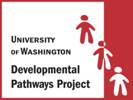
|
In the United States, emotional and behavioral health conditions cause approximately one in ten children to suffer significant impairment at school, at home, and in the community (Friedman et al., 1996). According to the 1999 Surgeon General’s Report these conditions “exact a staggering toll on millions of individuals, as well as on their families and communities” (Department of Health and Human Services, 2000). It is estimated that 46% of failure to complete secondary school in the U.S. is attributable to psychiatric disorders (Vander Stoep, et al, 2003). A key objective of Healthy People 2010 (Department of Health and Human Services, 2000) is reducing the prevalence of emotional and behavioral problems among children and adolescents as well as increasing our understanding of the developmental processes that cause them.
To address these issues, Drs. Ann Vander Stoep and Elizabeth McCauley from the Division of Child and Adolescent Psychiatry at the University of Washington and Seattle Children’s Hospital have built the Developmental Pathways Research Program that has three complementary branches aimed at understanding, identifying, and preventing depression, disruptive behavior, and related problems in adolescence. Dr. McCauley is a clinical psychologist who has conducted important studies that have helped us in understanding, treating, and preventing childhood depression, and Dr. Vander Stoep is a child psychiatric epidemiologist, who has studied the life course of children with emotional and behavioral problems. To support their research they have obtained funding from the National Institute of Mental Health and a number of private foundations and donors. A strong collaboration with the Seattle Public Schools and families within the district provides the foundation for the Developmental Pathways Research Program.
On the first branch (understanding) is the Developmental Pathways Project. DPP is an epidemiological study, meaning that participants are children in the general population and that the goal is to learn about the causes of a significant public health problem, in this case childhood depression and disruptive behavior. On the second branch (identifying) is the Developmental Pathways Screening Program in which students at risk of emotional health problems are identified as they transition to middle school. At risk students are then linked to services that will support their adjustment to middle school and academic success. On the third branch (preventing/intervening) is the High School Transition Project. HSTS is a randomized controlled trial of a preventive intervention program designed to support children who are at risk of becoming depressed as they make the challenging transition into high school. The preventive intervention program is a modification of Reconnecting Youth, a high school-based program that has been shown to be very successful at improving school performance and decreasing depression and suicidal behavior. The DPRP is carrying out and evaluating a number of other school-based intervention programs.
The Developmental Pathways Research Program will generate valuable information about how best to support children who are distressed as they navigate the challenging adolescent years. The investigators believe that establishing a research program with three complementary branches will maximize the contribution towards improving the adolescent mental and emotional health. It is exciting that national and local funders have invested their resources in the research projects carried out through a collaboration involving the University of Washington, Seattle Children’s Hospital, and the Seattle Public School District. We believe that by working together we can improve the emotional health of children in our community and promote improved school performance during the important middle and high school years. Other communities will benefit because Seattle children, parents, and teachers are contributing to help us understand how to identify and prevent prevalent mental health conditions that adversely affect success in school and overall growth and development.
—————————————————————————————— Department of Health and Human Services (2000). Healthy People 2010. National Health Promotion and Disease Prevention Objectives.
Department of Health and Human Services (2000). Mental Health: A Report of the Surgeon General.
Friedman RM, Katz-Leavy JW, Manderscheid RW, et al. (1996). Prevalence of serious emotional disturbance in children and adolescents. In Manderscheid RW & Sonnenschein MA (Eds.). Mental Health, United States, 1996. U.S. Department of Health and Human Services, Public Health Service. Rockville, MD. 71-89.
Vander Stoep A, Weiss NS, Saldanha E, Cheney D (2003). What proportion of failure to complete secondary school in the U.S. population is attributable to adolescent mental illness? Journal of Behavioral Health Services and Research 30:119-124. |

|
Program Overview |
|
Developmental Pathways Project |
|
University of Washington |

